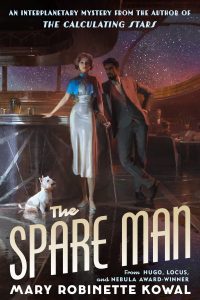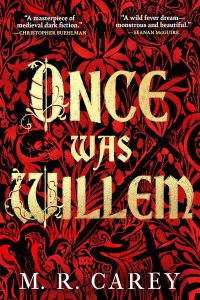Paul Di Filippo Reviews Antediluvian by Wil McCarthy
 Antediluvian, Wil McCarthy (Baen 978-1-4814-8431-2, $25, 320pp, hardcover) October 2019
Antediluvian, Wil McCarthy (Baen 978-1-4814-8431-2, $25, 320pp, hardcover) October 2019
Award-winning author Wil McCarthy has not brought forth a novel since—if I am reading his ISFDB entry aright—2005’s To Crush the Moon, and I suspect a whole new generation of readers is unfamiliar with his name and accomplishments: the ability to splendidly blend solid scientific outrageousness with slambang action and likable Everyman characters. That’s a shame, since, as critic John Clute opined when writing McCarthy’s entry in the Science Fiction Encyclopedia, solely on the basis of the tales issued up to 2005, “There is a strong sense that McCarthy’s best work may be yet to come.”
His new book, Antediluvian, confirms Clute’s hopes. It’s got a wowser of a core scientific speculation; plenty of vivid personages; and some philosophical and metaphysical heft as well.
We dive instantly and deeply into our narrative as we encounter two scientists on the day they intend to launch a major trial of a new device. Harv Leonel is an engineer with a side interest in the human genome—or as he calls it, the “quantome.” His premise is that human DNA has evolved to encode in its almost limitless stretches certain ancestral environmental information of a very specific sort. He’s been aided in the development of this theory by his lover, a post-doc paleontologist named Tara Mukherjee. Together, they’ve figured out how to decode the genetic bytes in every Y chromosome and play those bytes back into the human brain of anyone wearing a transcranial magnetic induction cap.
Into the lab they go, where Tara and another assistant, Patel, hook Harv up. They flick the switch, and Harv is instantly transported—mentally at least—across time. As his realer-than-real experiences unspool in his mind’s eye, he deduces that he is reliving incidents from the lifetime of an ancestor some twelve thousand years dead. And what a lifetime! Manuah is a prosperous sea trader in a lively coastal city unknown to our 21st-century historians. We get to experience his daily routines and his family life until the day a major tragedy strikes.
Harv gets kicked back to the present. The cap is removed. He begins to recount his visitation to Tara and Patel—and then another bout of recapitulation kicks in, unaided by machinery! His cells are primed for replay.
This time Harv is twenty thousand years gone by, living in the valley of Nog La, part of a Cro-Magnon community with Neanderthal neighbors. Another thrilling adventure ensues. Back to the present, then another trip, this time to an era of almost pre-verbal ancestors. And finally, the cycle replays once more, with a jaunt to the days of early hominids just learning to venture out onto the globe’s oceans. We close with the fallout of Harv’s experiment extrapolated into his near future, leaving more questions than answers.
Now, we need to evaluate three aspects of this novel: the frame tale, the vignettes, and how they hang together.
First, the “present-day” track is tightly constructed, with plenty of verisimilitude and a satisfying, albeit short and compressed arc, even including resolution of the romance between Harv and Tara.
The vignettes of course form the bulk of the tale, and must justify their own existences. I found each of them superbly intriguing and captivating. The first one reads like L. Sprague de Camp’s historical fiction, such as The Dragon of the Ishtar Gate. The second interval, with its bantering tribesmen, harks to The Clan of the Cave Bear series, with a touch of Monty Python absurdity. The last two episodes are the kind of stuff SF has been doing since the days of The Story of Ab (1897) and, more recently, Michael Bishop’s No Enemy But Time and Ancient of Days. In short, they are all bravura historical recreations, full of conjectural material from McCarthy’s researches.
What ties the vignettes together with the frame tale is the same kind of ancestral metaphysics that Jack London endorsed in The Star Rover: within each of us is buried the history of the species. It was a resonant conceit when London used it, and remains so in the hands of McCarthy, who makes us viscerally feel the connections that bind us to the past. In addition, McCarthy adds quantum entanglement to the mix, so as to hint that past and present are mutually influential on each other.
Presenting us with a colorful cast of characters from across the millennia who have thick and rich existences, and affirming that the cosmic stream of life flows forcefully despite all small blockades, McCarthy has written a novel that looks both forwards and backwards, thus making a stellar return to the field.
 While you are here, please take a moment to support Locus with a one-time or recurring donation. We rely on reader donations to keep the magazine and site going, and would like to keep the site paywall free, but WE NEED YOUR FINANCIAL SUPPORT to continue quality coverage of the science fiction and fantasy field.
While you are here, please take a moment to support Locus with a one-time or recurring donation. We rely on reader donations to keep the magazine and site going, and would like to keep the site paywall free, but WE NEED YOUR FINANCIAL SUPPORT to continue quality coverage of the science fiction and fantasy field.






